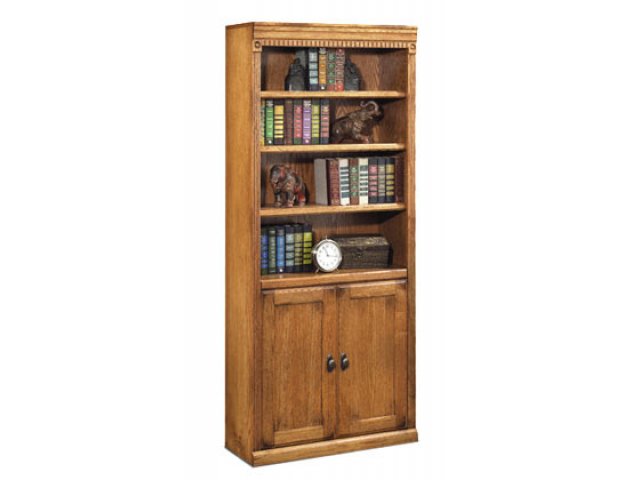My parents renovated their house last year, annexing the garage into the main living space. New hardwood floors with radiant heat. The only thing left to do is to come up with some sort of enclosure to hide the radiant heat controls.
I want to build a cabinet with a door on the front for easy access to the thermostat (that's the knob thing). To make maximum use of the space, I want to build a simple book case on top of the cabinet to hold CDs/ books.
The cabinet is going to be pretty small. The dimensions are 7 1/4" deep by 15 1/2" wide by 30" high. To match the floor, I think quartersawn white oak is an obvious choice. The bookcase will be very simple. Shiplapped back, one fixed shelf, and shelf pins for adjustable 3-4 adjustable shelves. The bookcase section will be ~48" tall.
I searched the web, and this approximates the objective:

My original idea was to do a frame-and-panel for the left side, a frame for the front, and then frame-and-panel doors. There's no right hand panel, all I'll have is a top rail (which will be secured to the wall). With the baseboard and outlets in awkward positions, it would be way too difficult to do cutouts in a real panel. I plan to run some strips of wood between the left panel and right floating rail for some stability (using pocket hole screws), like this:

and there will be a fixed shelf of course that acts as a top to the cabinet.
So basically, this is what I envisioned (but a lot smaller):
I'm worried the piece is too small for frame and panel. Even if I make the rails and stiles only 1" wide, that leaves only ~4" for the left panel field. Ditto for the doors. A flat panel could work, but a raised panel is probably too much. Also, 3/4" material seems overkill, but if I go with 1/2" material, I can't use my cope-and-stick router bits. It's easy to do simple flat sides, but I don't want it to look boxy/ bulky, and I'd like to add a little visual interest.
The real challenge is that I need to build it here in the US and then ship it in manageable pieces to Holland, finished and ready for assembly. I plan to use a combination of dowels and pocket hole screws to make this as simple as possible. Since I can't do a lot of fine tuning, I want to use overlay doors and Euro hinges.
Obviously, I need to go to the shop and grab some scrap material and build a prototype to see what looks good, but I could use some ideas. :widea: How do I keep this simple but attractive?
I want to build a cabinet with a door on the front for easy access to the thermostat (that's the knob thing). To make maximum use of the space, I want to build a simple book case on top of the cabinet to hold CDs/ books.
The cabinet is going to be pretty small. The dimensions are 7 1/4" deep by 15 1/2" wide by 30" high. To match the floor, I think quartersawn white oak is an obvious choice. The bookcase will be very simple. Shiplapped back, one fixed shelf, and shelf pins for adjustable 3-4 adjustable shelves. The bookcase section will be ~48" tall.
I searched the web, and this approximates the objective:

My original idea was to do a frame-and-panel for the left side, a frame for the front, and then frame-and-panel doors. There's no right hand panel, all I'll have is a top rail (which will be secured to the wall). With the baseboard and outlets in awkward positions, it would be way too difficult to do cutouts in a real panel. I plan to run some strips of wood between the left panel and right floating rail for some stability (using pocket hole screws), like this:

and there will be a fixed shelf of course that acts as a top to the cabinet.
So basically, this is what I envisioned (but a lot smaller):
I'm worried the piece is too small for frame and panel. Even if I make the rails and stiles only 1" wide, that leaves only ~4" for the left panel field. Ditto for the doors. A flat panel could work, but a raised panel is probably too much. Also, 3/4" material seems overkill, but if I go with 1/2" material, I can't use my cope-and-stick router bits. It's easy to do simple flat sides, but I don't want it to look boxy/ bulky, and I'd like to add a little visual interest.
The real challenge is that I need to build it here in the US and then ship it in manageable pieces to Holland, finished and ready for assembly. I plan to use a combination of dowels and pocket hole screws to make this as simple as possible. Since I can't do a lot of fine tuning, I want to use overlay doors and Euro hinges.
Obviously, I need to go to the shop and grab some scrap material and build a prototype to see what looks good, but I could use some ideas. :widea: How do I keep this simple but attractive?

